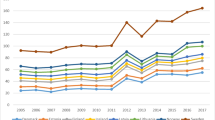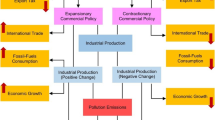Abstract
Over the past three decades, industrial innovations and technological advancements have changed business dynamics, adversely devastating the overall environment. As a result, our oceans have been severely affected due to climate change and global warming. To address this issue, this study investigates the factors that cause ocean CO2 using a sample of 44 countries over 2012–2021 and explores a dynamic and causal relationship between economic growth, ocean carbon dioxide emissions, energy consumption, and control variables relating to the ocean industry. This study finds that increasing economic activity tends to increase ocean carbon emissions. The results support the evidence of the environmental Kuznets curve (EKC) hypothesis suggesting an inverted U-shaped association between ocean emissions and real income for the sample countries. Moreover, this study reports that ocean health index, maritime container transport, trade of fishery and ocean species, aquaculture production and marine species, and employment rate in the fishery processing sector are the significant factors of ocean CO2. Region-wise analyses suggest that real income positively influences ocean emissions and confirm the evidence of the EKC hypothesis in European sample countries but these relationships have an insignificant effect in Asia and the Pacific and the American regions. Furthermore, a short-run unidirectional panel causality flows from the production of aquaculture and other species to RD&D, from OHI and GDP to trade of fishery and other species, and from OHI to employment rate in the fishery sector. Likewise, bidirectional causality runs from energy consumption and maritime transport to ocean CO2 in the long term. Regarding the long-run causal association, the results determine that all of the estimated coefficients of the lagged error correction terms are statistically significant which explains that they are crucial in the adjustment process as they deviate from the long-run equilibrium.

Similar content being viewed by others
References
Ahmed K, Qazi AQ (2014) Environmental Kuznets curve for CO2 emissions in Mongolia: an empirical analysis. Manag Environ Qual: An Int J 25(4):505–516
Alaganthiran JR, Anaba MI (2022) The effects of economic growth on carbon dioxide emissions in selected sub-Saharan African (SSA) countries. Heliyon 8:e11193
Apergis N, Payne J (2009) CO2 emissions, energy usage and output in Central America. Energy Policy 37:3282–3286
Apergis N, Payne J (2010) The emissions, energy consumption and growth nexus: evidence from the Commonwealth of Independent States. Energy Policy 38:650–655
Arellano M, Bover O (1995) Another look at the instrumental variable estimation of error-components model. J Econ 68(1):29e51
Arouri MH, Ben Youssef A, M’Henni H, Rault C (2012) Energy consumption, economic growth and CO2 emissions in Middle African countries. Energy Policy 45:342–349
Badircea RM, Manta AG, Florea NM, Puiu S, Manta LF, Doran MD (2021) Connecting blue economy and economic growth to climate change: evidence from European Countries. Energies 14:1–12
Bhargava A (2020) Econometric modelling of carbon dioxide emissions and concentrations, ambient temperatures and ocean deoxygenation. J R Stat Soc Series A 185:178–201
Blundell R, Bond S (1998) Initial conditions and moment restrictions in dynamic panel data models. J Econ 87(1):115e14
Blundell R, Bond S, Windmeijer F (2001) Estimation in dynamic panel data models: improving on the performance of the standard GMM estimator. In: Baltagi BH, Fomby TB, Hill RC (eds) Nonstationary panels, panel cointegration, and dynamic panels, vol 15. Emerald Group Publishing Limited, pp 53–91
Bond S, Hoeffler A, Temple J (2001) GMM estimation of empirical growth models. Working Paper No. 2001-W21. Nuffield College, University of Oxford, UK
Breitung J (2001) The local power of some unit root tests for panel data. In: Baltagi BH, Fomby TB, Hill RC (eds) Nonstationary panels, panel cointegration, and dynamic panels. Advances in Econometrics, vol 15. Emerald Group Publishing Limited, United Kingdom, pp 161–177
Choi I (2001) Unit root tests for panel data. J Int Money Financ 20:249–272
Dogan E, Aslan A (2017) Exploring the relationship among CO2 emissions, real GDP, energy consumption and tourism in the EU and candidate countries: evidence from panel model robust to heterogeneity and cross-sectional dependence. Renew Sust Energ Rev 77:239–245
Engel RF, Granger CWJ (1987) Cointegration and error correction: representation, estimation and testing. Econometrica 55:251–276l
Farhani S, Mrizak S, Chaibi A, Rault C (2014) The environmental Kuznets curve and sustainability: a panel data analysis. Energy Policy 71:189–198
Hadri K (2000) Testing for stationarity in heterogeneous panel data. Econ J 3:148–161
Hoeffler A (2002) The augmented Solow model and the African growth debate. Oxf Bull Econ Stat 64(2):135–158
Hsiao C (2014) Analysis of panel data, vol 54. Cambridge University Press
Im K-S, Pesaran H, Shin Y (2003) Testing for unit roots in heterogenous panels. J Econ 115:53–74
Intergovernmental Panel on Climate Change (2013) Climate change 2013: the physical science basis. Working Group I contribution to the IPCC Fifth Assessment Report. Cambridge University Press, Cambridge, United Kingdom www.ipcc.ch/report/ar5/wg1
Kao C (1999) Spurious regression and residual-based tests for cointegration in panel data. J Econ 90:1–44
Kasman A, Duman YS (2015) CO2 emissions, economic growth, energy consumption, trade and urbanization in new EU member and candidate countries. A panel data analysis. Econ Model 44:97–103
Lau L-S, Choong C-K, Eng Y-K (2014) Investigation of the environmental Kuznets curve for carbon emissions in Malaysia: do foreign direct investment and trade matter? Energy Policy 68:490–497
Levin A, Lin CF, Chu CSJ (2002) Unit root tests in panel data: asymptotic and finite-sample properties. J Econom 108:1–24
Maalej A, Cabagnols A (2020) CO2 emissions and growth. J Energy Dev 46(1/2):1–24
Maddala GS, Wu S (1999) A comparative study of unit root tests with panel data and a new simple test. Oxf Bull Econ Stat 61(S1):631–652
Nickell S (1981) Biases in dynamic models with fixed effects. Econometrica 49(6):1417–1426
Onofrei M, Vatamanu F, Cigu E (2022) The relationship between economic growth and CO2 emissions in EU countries: a cointegration analysis. Front Environ Sci 10:934885
Pedronni P (1999) Critical values for cointegration tests in heterogeneous panels with multiple regressors. Oxf Bull Econ Stat 61:653–670
Pedronni P (2004) Panel cointegration: asymptotic and finite sample properties of pooled time series tests with an application to the PPP hypothesis. Econ Theory 20:597–625
Roodman D (2009) A note on the theme of too many instruments. Oxf Bull Econ Stat 71(1):135–158
Tarakanov V (2022) How carbon emissions acidify our ocean? International Atomic Energy Agency (IAEA) Bulletin, 63–4. https://www.iaea.org/bulletin/how-carbon-emissions-acidify-ourocean
The Sustainable Development Goals Report (2022) United Nations. https://unstats.un.org/sdgs/report/2022/The-Sustainable-Development-Goals-Report-2022.pdf
Westerlund J (2007) Testing for error correction in panel data. Oxf Bull Econ Stat 69:0305–9049
World Ocean Review (2021) The ocean guarantor of life — sustainable use, effective protection. Published jointly by Maribus, International Ocean Institute, and German Marine Research Consortium, Germany
Zeebe RE, Zachos JC, Caldeira K, Toby T (2008) Oceans Carbon emissions and acidification Science. American Association for the Advancement of Science 321(5885):51–52. https://www.science.org/doi/10.1126/science.1159124
Zoundi Z (2017) CO2 emissions, renewable energy and the environmental Kuznets curve, a panel cointegration approach. Renew Sustain Energy Rev 72:1067–1075
Author information
Authors and Affiliations
Contributions
Conceptualization, data curation, writing the paper, review, and editing — MZM.
Corresponding author
Ethics declarations
Ethical approval
Not applicable.
Consent to participate
Not applicable.
Consent for publication
Not applicable.
Competing interests
The author declares no competing interests.
Additional information
Responsible Editor: V.V.S.S. Sarma
Publisher’s Note
Springer Nature remains neutral with regard to jurisdictional claims in published maps and institutional affiliations.
Appendix
Appendix
Rights and permissions
Springer Nature or its licensor (e.g. a society or other partner) holds exclusive rights to this article under a publishing agreement with the author(s) or other rightsholder(s); author self-archiving of the accepted manuscript version of this article is solely governed by the terms of such publishing agreement and applicable law.
About this article
Cite this article
Mumtaz, M.Z. What factors cause ocean CO2? A panel data analysis. Environ Sci Pollut Res 30, 123111–123125 (2023). https://doi.org/10.1007/s11356-023-30880-3
Received:
Accepted:
Published:
Issue Date:
DOI: https://doi.org/10.1007/s11356-023-30880-3




